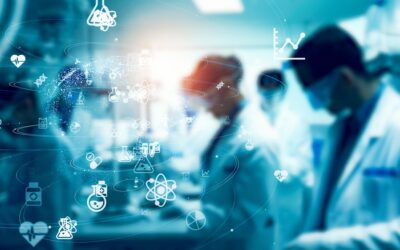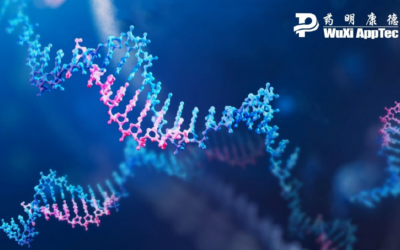Extractable and leachable (E/L) studies are becoming more and more important to drug development programs. Here’s why – and an overview of what E/L looks like for biopharma.
As drug manufacturing changes and becomes more flexible with plastic systems, the requirements for ensuring safety have changed with it. Single-use systems (SUS) used in the biomanufacturing process should be (and will be required in the future) evaluated for potentially harmful materials.
Today, a vast majority of modern manufacturing systems include plastic bags, tubing, bottles, valves and more. While the shift to plastic has improved quality and reduced production costs, the materials and the chemical constituents in those materials, could impact patient health.
In the absence of formal regulatory guidance, drug developers are turning to E/L testing to identify all of the chemical constituents in their product so that those chemicals can be assessed as part of a safety/risk assessment.
What Is E/L for Biopharma?
While biopharma manufacturers are well aware of the requirements for container closure systems and stability studies, recent USP <665> and <1665> updates have increased focus on E/L programs for plastic components used during the manufacturing process. E/L screening methods (not targeted studies) of these single-use systems are used to analyze and identify potentially harmful materials that may migrate out of the drug product. Forward-thinking biomanufacturers look at both extractables and leachables to create a complete assessment of potential safety hazards:
• Extractables: compounds that are “pulled” out of the product using strong solvents – typically an acid, a base and an organic solvent.
• Leachables: compounds that “migrate” out of the product using clinically relevant conditions – typically using the drug product.
The goal of E/L testing is to identify and quantitate the compounds that may be pulled or migrated out to evaluate the safety risk via the safety/toxicological risk assessment.
While there is currently no single, regulated approach for conducting E/L studies for biopharma applications, we compiled a list of helpful things to know when designing a study.
Designing a Biopharma E/L Study: 4 Essential Things to Know
1. E/L Studies Are 2 Separate Projects
Though they are talked about together, E/L studies are composed of two individual (yet connected) projects.
To achieve complete identification of all compounds, the extractables study comes first, establishing a baseline for the subsequent leachables study.
In 2014, the BioPhorum Operations Group (BPOG) published the first standardized extractable protocol, providing guidance on how to conduct extractables studies with the intent of having suppliers provide extractable data to their biopharma customers on their single-use components. In 2020, the group published a revised extractables testing protocol.
Often times, today, the SUS component suppliers can provide extractables data. From there, biomanufacturers can leverage SUS extractables data to design leachables studies based on the potential risk.
2. Regulatory Changes Are on the Horizon
To date, China is the only country with regulation requiring E/L for SUS. However, regulators are taking notice of the importance of E/L testing in biopharma. The EMEA, ICH, CFR and U.S. FDA have all alluded to the importance of evaluating these systems for extractables and leachables.
Recently, U.S. Pharmacopeia (USP) issued guidance that indicates what biomanufacturers can soon expect from regulatory bodies. Specifically, USP <665> and <1665> were released as official chapters and provide information to assess risk and a standardized testing procedure. These new chapters are a step forward in clarifying regulators’ expectations around fluid-contact equipment in biomanufacturing. This helps manufacturers prioritize which data they need to present to achieve regulatory success. While USP currently lacks enforcement capabilities, it’s clear that the U.S. FDA and other regulatory bodies are already asking for E/L information on these SUSs.
So, expect more formal regulation around E/L for biopharma in the near future. In the meantime, how should biomanufacturers approach their E/L program?
3. Follow a Risk-Based Approach
As mentioned, the goal of E/L for biopharma is to ensure patient safety as it relates to leachable compounds from the manufacturing and packaging processes. A part of this is also ensuring quality (efficacy and stability). As such, focus on factors that could potentially jeopardize patient safety or inhibit cell growth:
• Type of plastic.
• How much plastic surface area is in contact with the drug product.
• How long the drug product is in contact with the plastic.
• How close the plastic component is to the final drug product.
• Dose and route of exposure for the patient.
4. Full Chemical Characterization Is Expected
The purpose of extractables and leachables studies for biopharma is to identify potential risk. This can only be done with a complete chemistry report. Once chemicals are identified and quantified, they can be reviewed by a toxicologist to identify potential risk.
While full characterization of all chemicals is required for an accurate assessment of risk, this is easier said than done. To detect the full range of chemicals – including organic, semi-volatile and volatile chemicals – a biomanufacturer needs a range of validated analytical methods.
These techniques include:
• Liquid Chromatography-High Resolution Mass Spectrometry (LC-HRMS) to identify semi-volatile to non-volatile compounds.
• Gas Chromatography-Mass Spectrometry (GC-MS) to identify volatile and semi-volatile compounds.
• Headspace Gas Chromatography-Mass Spectrometry (HSGC-MS) to identify volatile and semi-volatile compounds.
Some methods are straightforward. However, identifying compounds from LC-HRMS, for example, can be more challenging because no commercial databases exist. This means it takes longer and requires even more work to make the identification. Therefore, it’s beneficial to work with a laboratory testing partner that has an existing database of compounds, expert scientists who can identify new compounds, and the commitment to complete chemical characterization.
E/L studies in biopharma is a journey. The goal is to identify what may migrate out and evaluate the risks of exposure to those compounds. It’s important to create an E/L test plan yet stay flexible. Continued communication and collaboration between chemists, toxicologists and biomanufacturers is key.
Conclusion
WuXi AppTec is committed to complete chemical characterization with no unknowns. We established our U.S. based chemistry lab and program 11 years ago based on this commitment and hold fast to it to this day. Talk to an expert about your upcoming project to see how we can help.
As a global company with operations across Asia, Europe, and North America, WuXi AppTec provides a broad portfolio of R&D and manufacturing services that enable global pharmaceutical and healthcare industry to advance discoveries and deliver groundbreaking treatments to patients. Through its unique business models, WuXi AppTec’s integrated, end-to-end services include chemistry drug CRDMO (Contract Research, Development and Manufacturing Organization), biology discovery, preclinical testing and clinical research services, cell and gene therapies CTDMO (Contract Testing, Development and Manufacturing Organization), helping customers improve the productivity of advancing healthcare products through cost-effective and efficient solutions. WuXi AppTec received AA ESG rating from MSCI in 2021 and its open-access platform is enabling more than 5,850 collaborators from over 30 countries to improve the health of those in need – and to realize the vision that “every drug can be made and every disease can be treated.”


